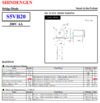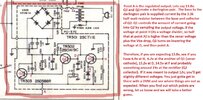View attachment 57621
I should have waited for a response to the other suggestions before posting this as I do believe the rectifier is a good candidate. Definitely start there!
I just have two random thoughts though. It was recapped 2 months ago. Was C302 put in backwards by chance? It kinda fits the failure timeline... The other though I had was that disconnecting the PS from the radio to see if the voltage comes up is
not necessarily a solid indication that the problem lies beyond the PS. Transistors don't always fail as shorts. It could be that the pass transistor Q3 in the regulator circuit has an open collector and Q2 is now acting as the pass transistor. I know, there would need to be a reason for Q3 to blow, likely a short on the main board, or old age, but it was said it did TX on the insufficient voltage, so... I can assume the final and AM regulator are functioning (right?), therefore I'm going with old age. If this were the case, Q3's old age, the voltage would still come up to the expected value as the load is removed ~ giving the illusion that the short is on the main board. If Q3 does turn out to have an open collector, Q2 will simply cause the circuit to act like a really wimpy regulated supply (like it seems to be behaving now).
Again, I should have waited for the results of the other suggestions to come in as this just clutters up the conversation, but I hate using the delete button, so, you're stuck with my inexperienced thoughts, lol.



